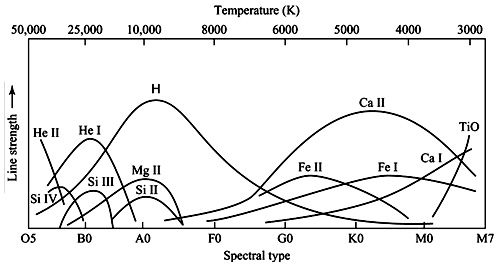Spectral Class
Classification scheme, also called the "Harvard Spectral Sequence," based on the strength of stellar spectral lines, which indicate a star’s temperature. Each category in this classification can be subdivided into 10 subclasses using numbers from 0 to 9. For example, the sequence for the O and B subclasses is O0, O1, O2, O3 … O8, O9, B0, B1…

The data column in the table below gives (in order): temperature (K), mass divided by Msun (M), radius divided by Rsun (R), luminosityBasic property used to characterize stars, luminosity is defined as the total energy radiated by a star each second. An object’s luminosity is often compared to that of the Sun (Lsun = 4 × 1033 ergs/s = 3.9 × 10 Watts). Luminosity has the same units as power (energy per divided by Lsun (L), and main-sequence lifespan (T).
ClassLinesDataExample(s)
OIonized He lines strong; multiply ionized metalElement that readily forms cations and has metallic bonds; sometimes said to be similar to a cation in a cloud of electrons. The metals are one of the three groups of elements as distinguished by their ionization and bonding properties, along with the metalloids and nonmetals. A diagonal line drawn lines; weak H lines
K = 28,000-50,000; M = 20-60;
R = 9-15; L = 90,000-800,000; T = 1-10 Ma
ζ Orionis
BNeutral He lines moderate; singly ionized metal lines; H lines moderate
K = 10,000-28,000; M = 3-18;
R = 3.0-8.4; L = 95-52,000; T = 11-400 Ma
Rigel (B8), Spica
ANeutral He lines very faint; Balmer H lines dominant, singly-ionized metal lines
K = 7,500-10,000; M = 2.0-3.0; R = 1.7-2.7; L = 8-55; T = 400-3,000 Ma
Vega (A0), Sirius (A1), Deneb
FH lines moderate, neutral and singly ionized metal lines
K = 6,000-7,500; M = 1.1-1.6; R = 1.2-1.6; L = 2.0-6.5; T = 3-7 Ga
Procyon, Canopus (F0)
GSingly ionized and neutral metal lines; H lines faint
K = 5,000-6,000; M = 0.85-1.1; R = 0.85-1.1;
L = 0.66-1.5; T = 7-15 Ga
SunOur parent star. The structure of Sun's interior is the result of the hydrostatic equilibrium between gravity and the pressure of the gas. The interior consists of three shells: the core, radiative region, and convective region. Image source: http://eclipse99.nasa.gov/pages/SunActiv.html. The core is the hot, dense central region in which the (G2), α Centauri (G2), Capella
KSingly ionized and neutral metals lines strong; molecular bands begin to appear; H lines faint
K =
3,500-5,000; M = 0.65-0.85; R = 0.65-0.85; L = 0.10-0.42; T = 17 Ga
Aldebaran (K5), Arcturus (K2)
MTi oxide molecular lines; neutral metal lines strong; molecular lines moderate; H lines very faint
K = 2,000-3,500; M = 0.08-0.65; R = 0.17-0.63; L = 0.001-0.08; T = 56 Ga
Antares, Betelgeuse
LStrong metal-hydride molecular bands (CrH, FeH), and neutral metals; TiO and VO bands are nearly absent.
K = ~1300-2500; M < 0.09; L = 10-5-10-6
brown dwarf
TStrong bands of methane (CH4) – like spectrum of Jupiter
K = 1500-2000; M < 0.09;
L = 10-6
cool brown dwarf

Image source: http://physics.uoregon.edu/~jimbrau/BrauImNew/Chap17/FG17_10.jpg.






